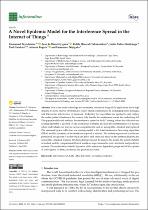A Novel Epidemic Model for the Interference Spread in the Internet of Things

View/
Date
2022Author
Tuyishimire, E
Niyigena, J
Tubanambazi, F
Bagula, A
Metadata
Show full item recordAbstract
: Due to the multi-technology advancements, internet of things (IoT) applications are in high
demand to create smarter environments. Smart objects communicate by exchanging many messages,
and this creates interference on receivers. Collection tree algorithms are applied to only reduce
the nodes/paths’ interference but cannot fully handle the interference across the underlying IoT.
This paper models and analyzes the interference spread in the IoT setting, where the collection tree
routing algorithm is adopted. Node interference is treated as a real-life contamination of a disease,
where individuals can migrate across compartments such as susceptible, attacked and replaced.
The assumed typical collection tree routing model is the least interference beaconing algorithm
(LIBA), and the dynamics of the interference spread is studied. The underlying network’s nodes are
partitioned into groups of nodes which can affect each other and based on the partition property, the
susceptible–attacked–replaced (SAR) model is proposed. To analyze the model, the system stability
is studied, and the compartmental based trends are experimented in static, stochastic and predictive
systems. The results shows that the dynamics of the system are dependent groups and all have points
of convergence for static, stochastic and predictive systems.
